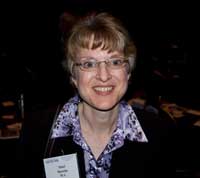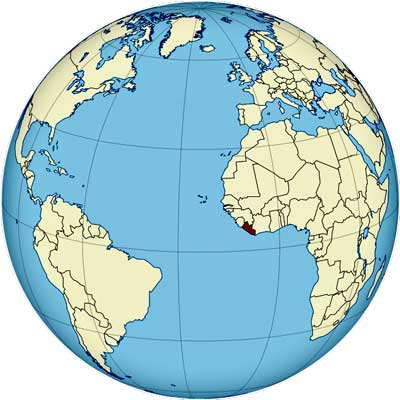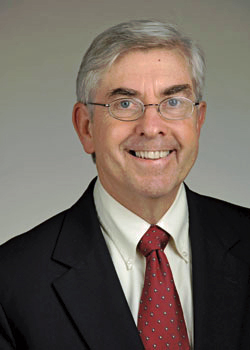



The NIH held a telebriefing with about 100 ME/CFS advocates, researchers and supporters Tuesday morning. This overview is taken from my notes of the meeting.
The Big Three – Dr. Francis Collins, Dr. Koroshetz and Dr. Nath – were all there – and that itself was something. How often, one wonders, does the head of the NIH, the head of the National Institute of Neurological Disorders and Stroke (NINDS) and the Clinical Director of NINDS sit down for an hour to discuss a study with patients? I imagine that doesn’t happen very often, and it’s certainly never happened in chronic fatigue syndrome (ME/CFS).
Plus Dr. Nath was calling from Liberia – from the American Embassy to boot – as he took a break from his Ebola work. (I wonder how he phrased his request to use the phone…I have to talk for an hour with this chronic fatigue syndrome group :). This has to be the first time ME/CFS has been discussed over a secure U.S. Embassy line :).
What was Nath doing there? Examining post-Ebola patients with neurological problems. Studying post-infectious illness, after all, is what Nath does. That’s why he’s interested in ME/CFS.
Could he compare post-Ebola and ME/CFS blood samples? (I can see the headlines “ME/CFS Found Similar to Post-Ebola Virus Syndrome”. THAT would rock everybody’s world.) Nath agreed that would be a fascinating study and that similarities exist between the two diseases, but that biological specimens – considered potentially infectious material – cannot be taken, at this point, out of the country.
Collins clearly wants to press home in every way he can the idea that the NIH is indeed finally taking ME/CFS seriously. He began by saying that the NIH “is very committed to this area of research” and will bring the “full resources” of the Clinical Center – the biggest research hospital in the world – to bear. Although the study will be limited to people with flu-like onset Collins said he believed the it would provide tranformative insights for everyone.
IRB approval for the study had just been received and they expect to launch the study this summer.
Collins himself brought up the “R” word – “RFA”. Virtually everyone in the ME/CFS community believes these money load grant opportunities are critical to jumpstarting a reinvigorated research effort. My notes state that Collins referred to RFA’s in both the short and long term, as he again reiterated that the NIH is “quite serious” about expanding ME/CFS research and bringing in new investigators.
Collins even mustered up something that could be construed as a kind of apology when he said something to the effect. “I understand that many of you have been waiting a long time for this kind of attention” and noted that Dr. Koroshetz had first experience of the devastating effects of ME/CFS. (Later Dr. Koroshetz will say the same thing about Dr. Nath).
Dr. Koroshetz
“We will stay the course”
Dr. Koroshetz spoke to what I believe is the most important issue when he emphatically stated that the NIH has embarked on a long term effort to understand ME/CFS. The intramural study is not a one-off study that the rest of the work depends on. It’s just the beginning of a large effort to understand ME/CFS.
Calling the ME/CFS a ‘difficult problem” to solve he stated the NIH would need the best and brightest from many fields – what he later called an “army of really good researchers” – to figure it out. Three times in his first statement he referred to the long term effort the NIH was going to engage in and promised they would “stay the course. ”
The NIH’s effort will begin with a neuro-immune focus but Koroshetz emphasized that they don’t know where the solution will come from and that all the Institutes needed to be involved.
Later Koroshetz called the almost 30 person investigative team an amazing group. He stated that each one is a full-time researcher with access to extraordinary tools. Nath noted that those 26 investigators that worked in laboratories contain about 150 people.
Vicky Whittemore
With that Dr. Koroshetz turned the discussion over to Vicky Whittemore who declared that the participants in the Trans NIH Working Group were “dedicated and passionate” about getting to the bottom of ME/CFS. Their short term plan is to activate the research field. Their longer term plan is to build the infrastructure – the interested academic centers and programs – needed to carry it forward.
The next step for the Working Group is to prepare the proposals they’ll take to their Institutes by May to sign off on (and hopefully fund). Koroshetz jumped in and noted that the process is by its very nature secret and because of that they can’t spell out exactly what they’re proposing. His goal, striking in its resemblance to what Ron Davis has proposed, was to form a consortium of investigators to take on ME/CFS.
Dr. Nath
Talking from the U.S. Embassy in Liberia on the only reliable phone line, Dr. Nath said he was delighted to be the principal investigator and was thrilled to take ME/CFS on. He said, if my notes are correct, that he’d seen a lot of patients with ME/CFS…(We appear to be getting around….)
From his perspective, the evidence suggests that ME/CFS is a neuro-immune disorder. He went over the different phases of the Clinical Center study: first an intense study of a smaller number of patients, then a longitudinal study using the results of the first study in a larger group of patients, and finally a treatment trial using immunomodulators.
Brian Walitt
Despite the outcry over Walitt the NIH is sticking with him. Walitt stated he’s a rheumatologist who had developed a specialization in fibromyalgia and ME/CFS. He emphasized that he believed that the disease was real, that it was not in patient’s heads and that he recognized that patients cannot push through their symptoms. He stated there was an urgent need for treatments.
Walitt said he will act as a coordinator during the study.
Question Period
Ampligen – Bob Miller asked if the NIH had figured Ampligen into their studies. Dr. Koroshetz stated they had met with representatives of Hemispherx Biopharma and had been presented with their data.
Myalgic Encephalomyelitis – Donna Pearson asked perhaps the most interesting question of the round: would the study have the ability to determine if the term encephalomyelitis is appropriate for the disease? Nath responded that the study will be able to determine if inflammation of the brain is present but will not be able to determine conclusively if immune cells have infiltrated into the brain which is needed for an encephalomyelitis diagnosis.
He did say that the animal studies they are doing would help them better answer that question. (The animal studies will transfer the immune systems of any CFS patients into the rodents.)
Nath, like Koroshtez before him, expected that the effort to get at the biological roots of ME/CFS would be a long one. He noted that the literature to date provides a lot of clues which have not been followed up on to determine if they apply to the broader population. Using populations big enough so that the results will be generalizable to the broader population (or to subsets of the population) will be a key goal of the study.
Nath noted that the protocol the teams at the Clinical Center use requires that researchers get up to date on every disease they encounter.
Ron Davis’s Involvement? – Ron Davis’s large exploratory study in the severely ill will be going on about the same time as Nath’s. I asked if Ron Davis was involved in the study, and if funding could be secured which would allow him to assess the results from the Clinical Center trial and vice versa. Nath said he was in contact with Davis and would collaborate with him but then got cut off.
Dr. Koroshetz stated the NIH hoped to interact with a series of investigators across the country to share their data and coordinate their approaches to this disorder. That sounds very much like the research network proposed by CFSAC and by the P2P authors. It also sounds somewhat like the Consortium proposed by Ron Davis. Davis envisioned groups of investigators working together to create a strategic approach to ME/CFS and then meeting for weekends to hash out what they had found and take the next steps.

Staci Stevens developed “The Stevens Protocol” used in the 2-day exercise tests – but is not part of the study.
Exercise Study and Workwell Group – I also asked that if, given the importance of the exercise study, Stacy Stevens and the Workwell group had been contacted. I stated that The Workwell group had originated the two day exercise protocol and had refined their technique over the past decade.
Brian Walitt stated that they were working with Dr. Unger of the CDC on the exercise study and that nobody else had been contacted but that they were open to more input. It’s certainly understandable that the NIH would go first to a sister agency for help and the CDC has carried out important exercise studies. They were one of the first groups, in fact, to do an exercise study in ME/CFS, but Dr. Unger is not an exercise physiologist and the CDC has never done two-day exercise studies.
I have no idea what could go wrong in an exercise study but I strongly believe that given the importance of this portion of the study that investigators associated with Workwell (Staci Stevens, Chris Snell and Mark Van Ness) should be included in the study.
That would be helpful both on the technical level and would the put the patient community – some of whom still do not trust the CDC – at ease. Take a worse case scenario – that the two day exercise test does not show a significant drop in energy production on the second day. That would be a difficult result for the patient community to accept without Workwell giving the thumbs-up to the study.
It’s also been stated that the two day exercise study results are so unusual as to invite disbelief from other exercise physiologists. All the better then to have multiple sets of eyes on the study to ensure that every last t is crossed and i is dotted.
Are 40 Patients Enough? – Charmain Proskauer asked if 40 patients would be enough to provide significant results? Nath replied that he felt comfortable with the number given the precise population they’ll be looking at (short duration infectious onset patients). If they didn’t find a neuroimmune signal in that number of patients he didn’t believe that neuroimmune processes were likely to play a major role. He didn’t need to find a “robust result” in all the patients, by the way; a good signal in a subset of patients would be important as well.
He also explained that because they’ll be looking at one patient a week, simply getting through all the patients will take almost a year. The next study will be much larger.
Including Patients and Experts Earlier in the Process – A representative from MEAdvocacy produced statements regarding their concerns about the implementation of the protocol without significant patient and expert input. She asked why the petition created by MEAdvocacy asking that the Study be halted and restarted using patient and expert input had not been responded to.
Dr. Koroshetz apologized for not addressing the petition question, and stated that the NIH group had met multiple times with ME/CFS experts, had conferred with the Trans NIH Working Group and was still learning about the patient community. He agreed that the history of medicine indicates that when you work with patients that you will get better results. He also expected to learn a lot from the patients in the study and he stated that the study protocol is and will be a work in progress.
Including Symptoms Other than Fatigue – Dr. Walitt said other symptoms would be assessed.
Bias – When asked about the possibility of bias Koroshetz reacted rather strongly stating that he had rarely if ever seen any at the NIH and that evidence of bias would be a “career breaker”. Nath pitched in and state that the design of the study prevented bias from surfacing.
A bias to shift the results in the PACE trial in a positive direction may have occurred but the PACE trial was a very different animal. The PACE trial investigators wanted to prove that their techniques worked. Because the NIH investigators, on the other hand, are trying to find answers to ME/CFS, the bias most likely to crop up for them is to interpret the study findings more positively than an outside observer might. Any positive findings they come up with, after all, would rebound to their benefit in the form of future studies.
RFA’s – Jennie Spotila asked if Dr. Koroshetz could make a commitment to an RFA being produced for ME/CFS. Dr. Koroshetz, for reasons he gave earlier, said that he couldn’t publicly commit to that, but that was the goal they were working toward.
Lyme Disease Cohort – Jennie also asked if the Lyme disease cohort was a great idea given the considerable overlap between it and chronic fatigue syndrome (ME/CFS) – if I got her question right. Dr. Nath replied that because the Lyme disease cohort consists of patients who had become infected and then recovered he felt they were a good control group for a disease which people who had been infected but had not recovered.
He also stated that the NIH had easy access to a Lyme disease cohort. The fact that the NIH had a Lyme disease specialist and his well-characterized patients on hand made it very easy to shoehorn them into the study. In a world of limited resources convenience helps.
A Structure for Patient and Expert Input – Jennie also asked about producing an infrastructure for patient and expert input. Vicky Whittemore reported that they are working on giving patients/experts access to one part of the Trans NIH Working Groups meeting. It seemed to me that Jennie was asking for something different; something like a review process that patients/experts would engage with regards to strategy, studies and the like. That did not seem to be forthcoming at this point.
Brian Wallit – Wilhelmina Jenkins gave Brian Walitt an opportunity to clear his name. Walitt said that ME/CFS is a biological disorder which research has shown effects every system in the body. If ME/CFS is in one’s head it’s only, he said, because the head is attached to the body.
$250 Million? – Another person asked if the NIH would be spending enough money on ME/CFS given that she believed that around $250 million per year is needed for a disease with ME/CFS’s prevalence and impact.
Dr. Koroshetz stated that no disease at the NIH received enough funding to meet the burden of illness it caused. Most of the NIH funding is allocated according to grant scores with the grants with the best scores getting funded first. He agreed, though, that the NIH needed to find a way to “fertilize” the ME/CFS research field and bring in highly trained investigators – and repeated that it would have to first stimulate the field with funding.
Conclusion
The most important thing for me was not just that NIH officials stated that they were committed to a long term effort on ME/CFS but that they repeatedly stated that. It was very good to hear that they publicly recognized that this is a complex, difficult to understand disorder which may not give up its secrets easily.
We’ll hear more about the NIH’s strategy for invigorating research into ME/CFS but it’s clear that it does not depend on the success of the intramural study. (For one thing the Clinical Center study is not going to begin until after the strategic plan has been signed off on.)
It was also encouraging that the NIH took it’s promised intramural study and turned it into a three part study – an early intense phase, a larger phase with longitudinal components to ensure that the biomarkers the first phase of the trial finds are real, and then finally a treatment intervention phase.
The talk about building a network of investigators that would coordinate their work was promising as well. While Collins and Koroshetz couldn’t speak directly to an RFA my sense was that they expected RFA’s to be involved. Several days ago the NIH announced that the functional movement disorder subset was removed from the study.
The Walitt Question
On the down side there doesn’t appear as yet to be an embedded structure that would allow patients/experts to engage with plans and studies as they are being created. Dr. Walitt continuing in his coordinator’s role will obviously upset probably many, but I would note that he is one of about thirty investigators involved in this study and he will not be interpreting the research.
If anyone thinks for a minute, though, that an immunologist with a hot finding is somehow going to allow a rheumatologist coordinator to slant his findings or play a role in assessing his work please think again.
This study is going to produce a stream of papers each of which is going to be authored by the prospective specialist. The gene guy or girl will write the gene paper, the NK cell guy or girl will write the NK cell paper and so on. Walitt is not there to write papers – he’s there to ensure that the study goes smoothly. (If my job at the NIH depended on a study that the Director of the NIH was personally involved in ran smoothly I would be darn sure it did.)
Dream Study
“We (the research community) are digging too deeply now not to find something.” Ron Davis
There is still work to be done on this study. Staci Stevens and Workwell need to be involved. Something should be done to ensure that the patients in the study get help at the end of it and their symptoms should be tracked over time. An organized structure for patient/expert input should be created.
My most fervent wish, though, has been for researchers to whack ME/CFS patients with exercise and then study everything they can about it. This study won’t assess everything; it won’t be focusing on the mitochondria, it won’t be assessing muscle blood flows, it doesn’t appear to have a blood volume component. There are probably many things this study isn’t doing but what it is doing is simply enormous. Nothing that has been done in the past even remotely approaches the scope of this study.
From extensive immune analyses before and after exercise, protein analyses, two kinds of brain scans, autonomic nervous system testing, microbiome analyses and spinal taps (not to mention growing neurons from ME/CFS stem cells and mice with ME/CFS immune systems) – the NIH is giving these courageous patients – and this disease – a big, big workup.
Having the Director of the NIH, the Director of NINDS and the director of NINDS clinical work heavily involved is a huge confidence builder, as well. (Who expected a call from Liberia? ). I expected we would get something like a small team of good researchers to take the lead in an effort that we could slowly build on – but not for these major figures to take such a visible role.
Time will tell how this all works out but from where I sit the news right now is very, very good and the future looks bright.
I think they will find something. It takes a lot to turn a healthy individual into someone who has trouble walking around the block or getting up from bed. Something major, major has happened and that something is lurking in there somewhere. All we’ve needed are the tools, the dedicated investigators, and the funding to find it.
There’s no reason with the incredible technology we have that it – or the pathway to it – won’t be found. Ron Davis – who knows technology – recently said that “we (the research community) are digging too deeply now not to find answers.”
Funding is always the knottiest problem but the NIH is clearly pumping a ton of money into the Clinical Center study and Collins and Koroshetz have committed themselves to a long term effort. Plus new technological advances are occurring almost daily. What we’ve needed is an “in” that gives us access to excellent researchers and the best technology on the planet. The strong Clinical Center study suggests that we may finally have that “in”.
My guess is these researchers are going to find multiple problems, that they’re going to produce validated biomarkers that legitimize the biological nature of ME/CFS, and that at some point in the not too distant future we’re going to look back and pinch ourselves at the distance we’ve come.












Thank you Cort, and everyone who gave input to this phone meeting. For now, I’m going to rest in some hopefulness. It will do my body good. There may be things to get up in arms about even now, and certainly there will be soon, but there are some incredible advances here and if I’m living in this moment those advances are very good.
Can you imagine that there would be a day when we wouldn’t have to be afraid to say we have CFS when seeing a new doctor, or wondering what comments our old doctor has made about us in our chart?? Wow, that will indeed BE THE DAY!!
I am seriously excited, quite amazed really. It’s been so very long; even reading about this study is some kind of surreal validation. Validation – now, you can’t get that with a Mastercard. (Actually, now I think about it you need to *give* validation with a credit card, not get it. Our illness finally being studied feels like Mastercard calling me up, giving me validation, and dumping a million bucks onto our my credit card ☺)
(Well, if I had one. Poor people try to avoid if possible)
Wow…I am rather stunned. I got sick in 1978, so after almost 30 years of living with all that has gone on, I can only hope that the technology is there to at last find this sucker! I thank you, Cort, for all the years of selfless dedication that you have given to the CFS community in keeping us all informed with your excellent reporting and your wonderful ability to cull down science talk so it makes sense to the lay person. This is indeed very exciting. I am thrilled!
Not almost 30years, but 40!! The journey has been long and difficult, but I still have HOPE!
Hi Cort,
Emotionally, it’s awfully hard to take “yes” for an answer after the way we’ve been treated for so long and the frustration at never being able to get our concerns addressed. But this sounds like at last we’ve gotten a “yes,” including some effort to demonstrate that they are now serious and ready to help us.
I didn’t care for the comment that no disease gets the funding they need for the burden it presents though. How many other diseases have been neglected and dissed for decades like ME/CFS? I think we deserve compensatory funding or extra funding reparations for this neglect.
What is an RFA?
The research at Columbia University showed different biomarkers for more recent patients vs. long term patients. Do you know if this going to inform the studies? It sounds like they are going to be looking at shorter term patients only at this point? Is that right? I have no objection to that because my guess is that these are the patients who have the best chance of recovery and so it is the best place to start. But what happens in the long term is important to investigate as well.
I was thinking today about the protests we launched regarding the IOM study but now I wonder if any of this would be happening had it not been done. It would be such a luxury to not have to be constantly suspicious and combative with the NIH and CDC to fight for ourselves. We could just follow President Reagan’s advice to “trust but verify.” I think even an informal private apology to our patient community would go a long way to building that trust but perhaps getting it right from now on is enough. Best, Esther
I agree that it is hard to hear that “yes” but when I look at what this study is actually doing – at the extensive testing they are doing before and after exercise – that “yes” really starts coming into focus.
Nobody has ever attempted a study of this scope before. (There were the twin studies of 15 years or so ago but these studies surpass those). I’d like to remind everyone who is crossing their fingers – and I am one of them – that in general the findings in most ME/CFS studies are positive….I don’t see why the findings from this study won’t be positive as well.
It’s going to be very, very interesting.
I am hoping that in the next few years we can have this luxury
“It would be such a luxury to not have to be constantly suspicious and combative with the NIH and CDC to fight for ourselves.”
This would not have happened without the IOM report. We were REALLY way off on that and thank god we didn’t win out. We needed an independent group from a respected Institute do a report that everyone would listen to. It was critical.
You have been our ear for all these years, and you could have easily quit, I am sure, out of sheer frustration . But here you are. Thank you.
Who cares what they find? Walitt admits there is “probably” something biological happening. He then just says it’s “normal” for that to happen.
Reminds me of the lab tests the primary care doctors do. The normal range is say 5-10, and your results come back at 3. “Don’t worry,” they say. “That’s ‘normal.'” So why have the test then, if everything is “normal?”
I suspect the same thing will happen here. Exercise drops off on the second day? Don’t worry, that’s normal. Cytokines aren’t showing up as expected? Don’t worry, that’s normal. Brain is a little bit inflamed? Don’t worry, that’s normal. Take some advil and don’t get back to us.
Walitt is a coordinator – not an investigator. He’s responsible for getting the patients to the investigators not doing any of the investigations. That means he’s not going to be writing ANY papers. The investigators will be writing the papers. I don’t think you need to worry about Walitt and his views.
I have to ask you, though, why the NIH be spending all this money and bringing in all these investigators if their goal was to prove ME/CFS was nothing? They could accomplish that goal much more easily by using some mid-level researchers and spending much less money on them.
In fact by doing so many tests, including tests that have been positive in the past, the odds that the NIH IS going to find something are actually very high. That suggests they are actually trying to find something.
I encourage you to keep an open mind. This study may work out very well 🙂
I hope Walitt wil send the right ME patiënts to Nath not the psychosomatic one’s 🙂
Gijis, yeah, I am always concerned about their patient base, also. But from what Cort said, they are only taking, at first, sudden on-set flu-like symptom patients, so I think that might eliminate what has muddied the waters before.
In fact they are ONLY taking patients from ME/CFS experts..
First an ME/CFS expert has to recommend them, then they have to flu-like onset and then they have to meet the CCC and other criteria; i.e. there aren’t going to be an psychosomatic patients – only patients cherry-picked for this study by doctors like Dr. Peterson, Dr. Klimas, Dr. Bateman, etc.
Thank you, Cort!
As a long-term, disabled patient I see reason to hope; but I want to know what I can do to help this along. I have contacted my congressman, Tom Price (R-GA) but I receive no concrete response. His office tells me that requests for additional NIH funding should now be made directly to the NIH. Seems like there should be a better answer than that.
Good for you to get in touch! I think tt will take a concerted campaign to get Congressman to sign off on a request for more funding. They are leery about telling the NIH what to do; they believe the experts should decide. Sometimes, though, the experts are clearly wrong.
I believe a campaign is in the works…
Cort, thank you so much for this excellent write-up and for all that you’ve done for our community. What you’ve summarized here is inspiring for all of us who have suffered far, far too long (for me personally it’s been over 30 years). Fingers crossed that we get some real answers, and some real treatments, very soon.
A million thanks Cort for all that you do. Was this recorded and will they post it? Very glad to hear Walitt is only a coordinator. That video of him was downright scary!
There is an audio version somewhere..I even have it somewhere but I’m sure where.
I find it difficult to keep up to date with all things M.E but I’m glad I read this today. Keeps hope alive. Thank you Cort for all you do to keep us informed!
Cort, please read my 2 comments and watch this NIH video with Brian Walitt if you haven’t done so. Thank you. http://www.cortjohnson.org/blog/2016/02/24/the-psychosomatic-researcher-in-the-nihs-big-chronic-fatigue-syndrome-mecfs-study/
If Brian Walitt doesn’t think that ME/CFS is a somatoform disorder all he has to do is say “I don’t think that ME/CFS is a somatoform disorder and this is why I CHANGED MY MIND….” He hasn’t done that.
Does anyone know if new Presidents generally keep or change NIH directors? On the precipice of progress, elections matter, not in terms of research funding.
As a total aside, Cort, you and others may be interested in this NYT article on whether research papers should be free: http://www.nytimes.com/2016/03/13/opinion/sunday/should-all-research-papers-be-free.html?_r=0
Make that: On the precipice of progress, elections matter, not only in terms of research funding.